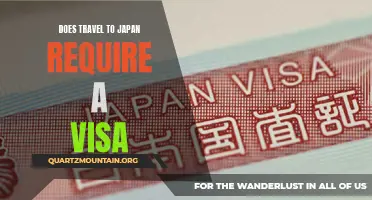
Are you planning on extending your travel visa and exploring more of the United States? Look no further! In this article, we will discuss various ways to extend your travel visa in the US, allowing you to continue your journey and immerse yourself in the rich culture and diverse landscapes this country has to offer. Whether you want to extend your visa for work, education, or simply to explore more, we have got you covered with tips and advice to make the process as smooth as possible. So, let's dive in and discover the different ways you can extend your travel visa in the US!
| Characteristics | Values |
|---|---|
| Eligibility | Non-immigrant visa holder |
| Application Form | Form I-539 |
| Filing Fee | $370 |
| Supporting Documents | Passport, Form I-94, Form I-539, Proof of financial support, Proof of return transportation |
| Processing Time | 3-5 months |
| Change of Status | Possible |
| filed within 6 months | before visa expiration |
| Possibility of denial | Yes, if requirements not met |
| Additional Biometrics | May be required |
| Premium Processing | Not available |
What You'll Learn

Understanding the process and requirements for extending your travel visa
If you're planning on staying in the United States longer than your approved travel visa allows, you may need to apply for an extension. The process and requirements for extending your travel visa can vary depending on the type of visa you have, so it's important to understand the specific guidelines that apply to your situation. Here's a step-by-step guide to help you navigate the process successfully:
- Determine your eligibility: Not all travel visas can be extended, so the first step is to confirm whether or not you're eligible. For example, B-1 and B-2 visas, which are commonly issued for tourism or business purposes, can usually be extended. On the other hand, visa categories like F-1 (student), J-1 (exchange visitor), and H-1B (work) have different rules for extensions. Check with the U.S. Citizenship and Immigration Services (USCIS) to determine the specific eligibility requirements for your visa type.
- File Form I-539: To apply for a visa extension, you'll need to fill out and submit Form I-539 - Application to Extend/Change Nonimmigrant Status. This form is available on the USCIS website and should be completed accurately and honestly. Make sure to read the instructions carefully and include all necessary supporting documentation, such as a copy of your current visa, passport, I-94 arrival/departure record, and any other relevant documentation.
- Pay the application fee: When submitting Form I-539, you'll also need to pay the appropriate application fee. As of 2021, the fee is $455. However, it's important to note that fees are subject to change, so it's always a good idea to double-check the current fee on the USCIS website before submitting your application.
- Submit your application: Once you have completed Form I-539 and gathered all the necessary documentation, submit your application by mail to the USCIS. Be sure to make a copy of your entire application package for your records and send it via a service that provides tracking and proof of delivery.
- Await a decision: After submitting your application, you'll need to wait for a decision from the USCIS. The processing time can vary, but it typically takes several months. During this waiting period, it's essential to maintain lawful status in the U.S. and comply with all visa requirements, including any restrictions on employment or travel.
- Be prepared for an interview: In some cases, the USCIS may request an interview to further evaluate your visa extension application. If this happens, make sure to attend the interview at the designated date, time, and location. Be prepared to answer questions about your travel plans, reasons for the extension, and any supporting documentation you provided with your application.
- Keep your documents updated: While waiting for a decision or during the extension period, it's crucial to keep your travel documents up to date. This includes ensuring that your passport remains valid for the duration of your stay and that you have an updated visa whenever necessary. Failure to maintain valid and current travel documents may result in complications or adversely affect your immigration status.
It's essential to start the process of extending your travel visa well before your current visa expires. Delays or last-minute applications may result in a denial or the need to leave the United States before your desired extension period.
Remember that this guide provides a general overview of the visa extension process, and the specific requirements can vary based on your visa type and individual circumstances. It's always a good idea to consult with an immigration attorney or seek guidance from a reputable immigration service for personalized advice and assistance.
How to Enter Cruise Details for Visa Travel History
You may want to see also

Exploring options for extending your stay in the United States
If you are traveling to the United States and find that you need to extend your stay, there are several options available to you. Whether you are a tourist, a student, or here on a work visa, it is important to explore these options to ensure you are in compliance with U.S. immigration laws and regulations. In this article, we will discuss some of the most common ways to extend your stay in the United States.
Apply for a Visa Extension:
One of the most straightforward ways to extend your stay in the United States is to submit a visa extension application to U.S. Citizenship and Immigration Services (USCIS). This option is available to both tourists and students. To apply for a visa extension, you will need to complete Form I-539, Application to Extend/Change Nonimmigrant Status. Be sure to read the instructions carefully and provide all required documents and supporting evidence. It is also vital to submit your application well in advance of your current visa expiration date to allow sufficient processing time.
Apply for a Change of Status:
If you are in the United States under a nonimmigrant visa, you may be able to request a change of status to a different visa category. For example, if you entered the U.S. as a tourist but now want to study, you can apply for a change of status to a student visa. To do so, you will need to complete Form I-539 and provide the necessary supporting documentation. However, it is important to note that not all visa categories are eligible for a change of status, so check with USCIS to determine if this option applies to your situation.
Enroll in a Study Program:
If you are a student and want to extend your stay in the United States, enrolling in a study program can be an excellent option. By obtaining an acceptance letter from a U.S. educational institution, you can apply for a student visa, such as an F-1 or M-1 visa. These visas allow you to stay in the U.S. for the duration of your program and sometimes offer the opportunity to apply for optional practical training (OPT) after completing your studies.
Apply for Optional Practical Training:
If you are a student on an F-1 visa and have completed your studies, you may be eligible for optional practical training (OPT). This allows you to work in the United States for a specific period of time, typically up to 12 months. OPT provides an excellent opportunity to gain valuable work experience while extending your stay in the U.S. Be sure to consult with your designated school official (DSO) for guidance on how to apply for OPT.
Explore Employment-Based Visas:
If you are working in the United States and need to extend your stay, you may be eligible for an employment-based visa. There are several different visa categories available, depending on your occupation and qualifications. The most common employment-based visas include the H-1B, L-1, and O-1 visas. Each visa category has its own requirements and application process, so it is advisable to consult an immigration attorney or an experienced immigration professional for guidance.
In conclusion, if you find yourself in need of extending your stay in the United States, there are various options available to you. From visa extensions and changes of status to study programs and employment-based visas, it is essential to explore these options and choose the one that best suits your situation. Remember to thoroughly review the requirements and seek professional guidance if needed to ensure a smooth and successful extension of your stay in the United States.
Exploring the Possibility: Traveling with an Expired Visa
You may want to see also

Step-by-step guide on how to apply for a visa extension
If you are currently in the United States on a travel visa and wish to extend your stay, you may be eligible to apply for a visa extension. The process can seem daunting at first, but with the right information and preparation, it can be a straightforward process. In this step-by-step guide, we will walk you through the necessary steps to successfully apply for a visa extension in the United States.
- Determine your eligibility: Before applying for a visa extension, you need to determine if you are eligible for an extension. Generally, you can apply for a visa extension if your current visa has not expired, you have not committed any crimes or violated any immigration laws, and you have a valid reason for needing an extension.
- Gather the required documents: The next step is to gather all the necessary documents for your visa extension application. These documents may include your passport, I-94 Arrival/Departure record, Form I-539 Application to Extend/Change Nonimmigrant Status, supporting documents such as a letter explaining your reason for the extension, and evidence of your financial ability to support yourself during your extended stay.
- Complete Form I-539: Form I-539 is the application to extend or change nonimmigrant status, and it is the main form you will need to complete for your visa extension application. Make sure to fill out the form accurately and provide all the required information. It's important to note that each applicant, including dependents, must submit a separate Form I-539.
- Pay the application fee: There is a filing fee associated with the visa extension application. As of [current year], the fee for Form I-539 is $370. You can find the most up-to-date fee information on the official U.S. Citizenship and Immigration Services (USCIS) website. Make sure to include the fee payment with your application.
- Submit your application: Once you have completed Form I-539 and gathered all the required documents, it's time to submit your application. Make a copy of your entire application package for your records before mailing it to the appropriate USCIS Service Center. The specific mailing address can be found on the USCIS website.
- Wait for a decision: After submitting your application, you will need to wait for a decision from USCIS. The processing time can vary, so it's important to be patient. You can check the USCIS website for current processing times to get an idea of how long you may have to wait.
- Attend biometrics appointment (if required): In some cases, USCIS may require you to attend a biometrics appointment, where they will collect your fingerprints, photograph, and signature. If you are required to attend a biometrics appointment, USCIS will send you a notice with the date, time, and location of your appointment.
- Keep your visa status valid: While you are waiting for a decision on your visa extension application, it's essential to keep your visa status valid. This means you should not overstay your authorized period of stay, which can negatively affect your future immigration applications.
- Receive a decision: Once USCIS has reviewed your application, they will send you a decision in the mail. If your application is approved, you will receive a new Form I-94 with an extended validity date. If your application is denied, the notice will explain the reasons for the denial.
- Follow the instructions on the decision notice: Depending on the decision of your visa extension application, you will need to follow the instructions provided on the decision notice. If your application is approved, make sure to keep a copy of the new Form I-94 and carry it with you when you travel. If your application is denied, you may need to make alternative arrangements, such as departing the United States before your current visa expires.
Applying for a visa extension in the United States may seem like a complex and overwhelming process, but by following this step-by-step guide and providing all the required documents and information, you can increase your chances of a successful outcome. Remember to always check the USCIS website for the most up-to-date information and consult with an immigration attorney or professional if you have any specific questions or concerns about your visa extension application.
How to Change a Travel Visa to a Marriage Visa
You may want to see also

Common mistakes to avoid when extending your travel visa in the US
Extending a travel visa in the US can be a complex process. From gathering the necessary documentation to navigating the bureaucratic procedures, there are several common mistakes that applicants make. Avoiding these mistakes can save you time, money, and unnecessary stress. So, if you are planning to extend your travel visa in the US, here are some common mistakes you should avoid:
Failing to plan ahead:
Extending your travel visa requires careful planning. Start the process well before your current visa expires to avoid any last-minute complications. It is recommended to begin the extension process at least three months in advance.
Not understanding the eligibility criteria:
Each visa category has specific eligibility criteria for extension. Make sure you understand the requirements for your particular visa category before applying. These criteria may include maintaining valid reasons for your extended stay, proving sufficient funds, and demonstrating ties to your home country.
Incorrectly filling out the application forms:
One of the most common mistakes applicants make is incorrectly filling out the application forms. Double-check all the information you provide, particularly your personal details and visa category. Any mistakes or inconsistencies can lead to delays or even rejection of your application.
Not providing sufficient supporting documents:
Supporting documents play a crucial role in the visa extension process. Failure to provide the required documentation can result in the rejection of your application. Make sure you have all the necessary documents, such as bank statements, proof of employment or enrollment, and a valid passport.
Underestimating the processing time:
The U.S. Citizenship and Immigration Services (USCIS) takes time to process visa extension applications. It is crucial to understand the current processing times and submit your application accordingly. Applying too close to your current visa's expiration date may lead to an overstay, while applying too early may result in a delayed approval.
Neglecting to maintain your legal status:
While waiting for your visa extension, it is essential to maintain your legal status in the US. Overstaying your visa can have severe consequences and may even affect your chances of obtaining future visas. Follow the rules and regulations, and, if necessary, file for a change of status or apply for another visa category before your current visa expires.
Failing to seek professional advice:
Navigating the visa extension process alone can be challenging, especially if you are unfamiliar with the procedures and requirements. Seeking professional advice from an immigration attorney or experienced consultant can significantly increase your chances of a successful visa extension. They can guide you through the entire process, ensuring that you avoid any potential mistakes.
Extending your travel visa in the US requires careful planning, attention to detail, and adherence to the rules and regulations. By avoiding these common mistakes, you can streamline the process and increase your chances of a successful visa extension. Remember to start early, understand the eligibility criteria, provide accurate documentation, and seek professional assistance if needed. With proper preparation and a clear understanding of the process, you can extend your stay in the US without unnecessary complications.
Exploring the New Frontier: Traveling with a Digital Visa
You may want to see also
Frequently asked questions
To extend your travel visa in the US, you need to file an application with the United States Citizenship and Immigration Services (USCIS). You should submit Form I-539, Application to Extend/Change Nonimmigrant Status, along with the required supporting documents and payment of the filing fee. It is advisable to apply for an extension well before your current visa expires.
Yes, you can still apply for a visa extension even if your current visa has expired. However, it is important to note that staying in the US beyond the expiration date of your visa without a valid extension application may result in an overstay and potential immigration consequences. It is recommended to file the extension application as soon as you realize the need for an extension.
The processing time for a visa extension application can vary depending on various factors, such as the USCIS workload and the type of visa being extended. Generally, it can take several months for the application to be processed. It is important to apply for an extension well before your current visa expires to allow enough time for processing.
The specific documents required for a visa extension application may vary depending on the type of visa being extended. However, some common documents that are often required include a completed Form I-539, a copy of your current visa, a letter explaining the need for the extension, supporting financial documents, and any other relevant supporting documents specific to your situation. It is important to review the USCIS website or consult with an immigration attorney to ensure you have all the necessary documents.
It is generally not recommended to travel internationally while your visa extension application is pending. If you leave the US while your application is being processed, your application may be considered abandoned, and you may face difficulties re-entering the US. It is best to consult with an immigration attorney before making any international travel plans while an extension application is pending.







